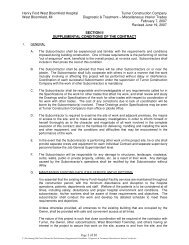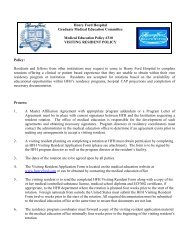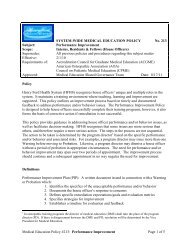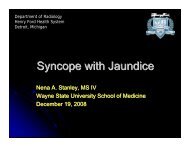Case Presentation Vaginal Bleeding
Case Presentation: Vaginal Bleeding - Henry Ford Health System
Case Presentation: Vaginal Bleeding - Henry Ford Health System
- No tags were found...
Create successful ePaper yourself
Turn your PDF publications into a flip-book with our unique Google optimized e-Paper software.
Department of Radiology<br />
Henry Ford Health System<br />
Detroit, Michigan<br />
<strong>Case</strong> <strong>Presentation</strong>:<br />
<strong>Vaginal</strong> <strong>Bleeding</strong><br />
Justin Dueweke, MSIII<br />
Emi Masuda, PGY-II<br />
Wayne State University School of Medicine<br />
6/19/2009
History<br />
• 22 year old presents to the ED with vaginal<br />
bleeding and severe abdominal cramping<br />
over the past few hours<br />
• Serum HCG level = 9417<br />
• LMP ~3 months ago<br />
• Patient not aware that she had been<br />
pregnant.
OB Ultrasound - Transabdominal
OB Ultrasound - Transabdominal<br />
No Heart Tones
OB Ultrasound - Transabdominal
OB Ultrasound - Transabdominal
OB Ultrasound - Transabdominal
OB Ultrasound - Transabdominal<br />
edematous<br />
abdominal wall
Our Report<br />
• FINDINGS:<br />
An intrauterine gestational sac is identified with a crown-rump rump length of 54<br />
mm corresponding to gestational age of 12 weeks and 1 day. No fetal heart<br />
tones are identified despite multiple attempts. There is evidence of diffuse<br />
fetal hydrops. . There is a hypoechoic cystic structure in the fetal head/neck<br />
region bilaterally, the largest cystic structure measuring approximately 2.5 x<br />
1.5 x 1.4 cm. There is discontinuation of the cranium.<br />
[Ovaries unremarkable, small amt of free fluid in cul-de<br />
de-sac]<br />
• IMPRESSION:<br />
Findings consistent with intrauterine fetal demise with no visualized<br />
heart tones, fetal hydrops, and cystic abnormality of the head/neck eck which<br />
may relate to cystic hygroma…
Differential Dx – Cystic Structure<br />
• Cystic Hygroma<br />
• Neural Tube Defect<br />
• Posterior Encephalocele, Cervical Meningocele<br />
• Cystic Teratoma<br />
• Hemangioma
What is Cystic Hygroma?<br />
• Congenital malformation of lymphatics<br />
• Communication between lymph and venous pathways<br />
leads to fluid accumulation in the jugular lymphatic sacs<br />
• May be septated or simple<br />
• Prevalence: 1 in 100 1 st trimester fetuses
Cystic Hygroma –<br />
Chromosomal Abnormalities<br />
• 1 st Trimester – Often trisomies<br />
• 2 nd Trimester – Usually Monosomy X (Turner’s)<br />
• Simple vs Septated Hygroma<br />
• Septated more likely a chromosomal abnormality<br />
• In one study of 1 st Trimester Simple Cystic Hygromas >2mm:<br />
• 60% had abnormal karyotype<br />
• ¼ of these were Trisomy 21<br />
• However, studies have not been consistent in their findings about<br />
correlation between size, septation, and chromosome abnormalities,<br />
or even overall incidence.
Cystic Hygroma –<br />
Other Abnormalities<br />
• Up to 1/3 of euploid fetuses with cystic hygroma will have major<br />
structural abnormalities<br />
• Including: cardiac defects, diaphragmatic hernia, renal anomalies, and<br />
abdominal wall defects<br />
• In addition, there are also associations with other rare diseases s and<br />
syndromes…<br />
• …multiple pterygium syndrome, Cornelia de Lange syndrome, Noonan<br />
syndrome, Roberts syndrome, and skeletal dysplasias
Non-Immune Hydrops Fetalis<br />
CAUSES:<br />
• Cardiovascular Abnormalities – up to 40%<br />
• Anemia – up to 27%<br />
• Lysosomal Storage Diseases – up to 15%<br />
• Chromosomal – ~10%<br />
• Monosomy X: 42-67% of this<br />
• Trisomy 21: 23-30%<br />
30%<br />
• The development of hydrops in these cases generally secondary to<br />
lymphatic dysplasia…<br />
• Thoracic Abnormalities - ~10%<br />
• Infection – ~8%
Wrapping Up<br />
• Recall that 50-65% of 1 st trimester fetal loss is due to fetal<br />
chromosomal abnormality<br />
• Most common single abnormality is Monosomy X - ~14%<br />
• Trisomies account for ~25%<br />
• Most common is Trisomy 21<br />
• Although we do not have a pathologic diagnosis, it is extremely<br />
likely the fetus had a chromosomal abnormality.<br />
• Probably either Monosomy X or Trisomy 21<br />
Follow up: The patient was sent home from the ER after a dose of Cytotec<br />
and instructed to return for a D&C in the AM however she passed tissue at<br />
home. Follow up US was negative for IUP or retained products.
References<br />
• Graesslin, O, Derniaux, E, Alanio, E, et al. Characteristics and<br />
outcome of fetal cystic hygroma diagnosed in the first trimester. . Acta<br />
Obstet Gynecol Scand 2007; 86:1442.<br />
• Malone, FD, Ball, RH, Nyberg, DA, et al. First-trimester trimester septated<br />
cystic hygroma. Prevalence, natural history, and pediatric outcomes<br />
mes.<br />
Obstet Gynecol 2005; 106:288.<br />
• Puscheck, EE, et al. First trimester pregnancy loss. In: eMedicine.<br />
Accessed 2009.<br />
• Simpson, LL, et al. First trimester cystic hygroma and enlarged<br />
nuchal translucency. . In: UpToDate, Basow, DS (Ed), UpToDate,<br />
Waltham, MA, 2009.<br />
• Lockwood, CJ, et al. Nonimmune hydrops fetalis. . In: UpToDate,<br />
Basow, DS (Ed), UpToDate, Waltham, MA, 2009.
















